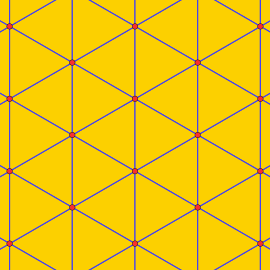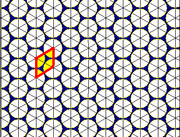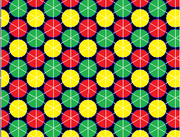Triangular tiling
| Triangular tiling | |
|---|---|
 | |
| Type | Regular tiling |
| Vertex configuration | 3.3.3.3.3.3 (or 36) |
| Face configuration | V6.6.6 (or V63) |
| Schläfli symbol(s) | {3,6} {3[3]} |
| Wythoff symbol(s) | 6 | 3 2 3 | 3 3 | 3 3 3 |
| Coxeter diagram(s) | |
| Symmetry | p6m, [6,3], (*632) |
| Rotation symmetry | p6, [6,3]+, (632) p3, [3[3]]+, (333) |
| Dual | Hexagonal tiling |
| Properties | Vertex-transitive, edge-transitive, face-transitive |
In geometry, the triangular tiling is one of the three regular tilings of the Euclidean plane. Because the internal angle of the equilateral triangle is 60 degrees, six triangles at a point occupy a full 360 degrees. The triangular tiling has Schläfli symbol of {3,6}.
Conway calls it a deltille, named from the triangular shape of the Greek letter delta (Δ). The triangular tiling is roughly the kishextile.
It is one of three regular tilings of the plane. The other two are the square tiling and the hexagonal tiling.
Uniform colorings
There are 9 distinct uniform colorings of a triangular tiling. (Naming the colors by indices on the 6 triangles around a vertex: 111111, 111112, 111212, 111213, 111222, 112122, 121212, 121213, 121314)
Four of the colorings are generated by Wythoff constructions. Seven of the nine distinct colorings can be made as reductions of the four coloring: 121314. The remaining two, 111222 and 112122, have no Wythoff constructions.
| Coloring indices |
111111 | 121212 | 121213 | 121314 |
|---|---|---|---|---|
| Coloring | 
|

|

|

|
| Symmetry | *632 p6m [6,3] |
*333 p3m1 [3[3]] = [1+,6,3] |
3*3 p31m [6,3+] |
333 p3 [3[3]]+ |
| Wythoff symbol | 6 | 3 2 | 3 | 3 3 | | 3 3 3 | |
| Coxeter diagram | ||||
| Schläfli symbol | {3,6} | h{6,3} | s{3,6} | s{3[3]} |
| Coloring indices |
111222 | 112122 | 111112 | 111212 | 111213 |
|---|---|---|---|---|---|
| Coloring | 
|

|

|

|

|
| Symmetry | 2*22 cmm [∞,2+,∞] |
2222 p2 [∞,2,∞]+ |
*333 p3m1 [3[3]] |
*333 p3m1 [3[3]] |
333 p3 [3[3]]+ |
A2 lattice and circle packings
The vertex arrangement of the triangular tiling is called an A2 lattice.[1] It is the 2-dimensional case of a simplectic honeycomb.
The A*
2 lattice (also called A3
2) can be constructed by the union of all three A2 lattices, and equivalent to the A2 lattice.


 +
+ 

 +
+ 

 = dual of
= dual of 

 =
= 


The vertices of the triangular tiling are the centers of the densest possible circle packing. Every circle is in contact with 6 other circles in the packing (kissing number). The packing density is or 90.69%. Since the union of 3 A2 lattices is also an A2 lattice, the circle packing can be given with 3 colors of circles.
The voronoi cell of a triangular tiling is a hexagon, and so the voronoi tessellation, the hexagonal tiling has a direct correspondence to the circle packings.
| A2 lattice circle packing | A* 2 lattice circle packing |
|---|---|

|

|
| Hexagonal tilings | |

|

|
Related polyhedra and tilings
The planar tilings are related to polyhedra. Putting fewer triangles on a vertex leaves a gap and allows it to be folded into a pyramid. These can be expanded to Platonic solids: five, four and three triangles on a vertex define an icosahedron, octahedron, and tetrahedron respectively.
This tiling is topologically related as a part of sequence of regular polyhedra with Schläfli symbols {3,n}, continuing into the hyperbolic plane.
| *n32 symmetry mutation of regular tilings: {3,n} | |||||||||||
|---|---|---|---|---|---|---|---|---|---|---|---|
| Spherical | Euclid. | Compact hyper. | Paraco. | Noncompact hyperbolic | |||||||

|

|

|

|

|

|

|

|

|

|

|

|
| 3.3 | 33 | 34 | 35 | 36 | 37 | 38 | 3∞ | 312i | 39i | 36i | 33i |
It is also topologically related as a part of sequence of Catalan solids with face configuration Vn.6.6, and also continuing into the hyperbolic plane.
 V3.6.6 |
 V4.6.6 |
 V5.6.6 |
 V6.6.6 |
 V7.6.6 |
Wythoff constructions from hexagonal and triangular tilings
Like the uniform polyhedra there are eight uniform tilings that can be based from the regular hexagonal tiling (or the dual triangular tiling).
Drawing the tiles colored as red on the original faces, yellow at the original vertices, and blue along the original edges, there are 8 forms, 7 which are topologically distinct. (The truncated triangular tiling is topologically identical to the hexagonal tiling.)
| Uniform hexagonal/triangular tilings | |||||||||||
|---|---|---|---|---|---|---|---|---|---|---|---|
| Symmetry: [6,3], (*632) | [6,3]+ (632) |
[6,3+] (3*3) | |||||||||
| {6,3} | t{6,3} | r{6,3} | t{3,6} | {3,6} | rr{6,3} | tr{6,3} | sr{6,3} | s{3,6} | |||

|

|

|

|

|

|

|

|

| |||
| 63 | 3.122 | (3.6)2 | 6.6.6 | 36 | 3.4.6.4 | 4.6.12 | 3.3.3.3.6 | 3.3.3.3.3.3 | |||
| Uniform duals | |||||||||||

|

|

|

|

|

|

|

|

| |||
| V63 | V3.122 | V(3.6)2 | V63 | V36 | V3.4.6.4 | V.4.6.12 | V34.6 | V36 | |||
| Wallpaper group |
Triangle symmetry |
Extended symmetry |
Extended diagram |
Extended group |
Honeycombs |
|---|---|---|---|---|---|
| p3m1 (*333) | a1 |
[3[3]] | (none) | ||
| p6m (*632) | i2 |
[[3[3]]] ↔ [6,3] | |||
| p31m (3*3) | g3 |
[3+[3[3]]] ↔ [6,3+] | (none) | ||
| p6 (632) | r6 |
[3[3[3]]]+ ↔ [6,3]+ | |||
| p6m (*632) | [3[3[3]]] ↔ [6,3] |
| Triangular symmetry tilings | |||||||||||
|---|---|---|---|---|---|---|---|---|---|---|---|
| Wythoff | 3 | 3 3 | 3 3 | 3 | 3 | 3 3 | 3 3 | 3 | 3 | 3 3 | 3 3 | 3 | 3 3 3 | | | 3 3 3 | |||
| Coxeter | |||||||||||
| Image Vertex figure |
 (3.3)3 |
3.6.3.6 |
 (3.3)3 |
 3.6.3.6 |
 (3.3)3 |
 3.6.3.6 |
 6.6.6 |
3.3.3.3.3.3 | |||
Triangular tiling variations
Triangular tilings can be made with the identical {3,6} topology as the regular tiling (6 triangles around every vertex). With identical faces (face-transitivity) and vertex-transitivity, there are 5 variations. Symmetry given assumes all faces are the same color.[2]
-
Scalene triangle
p2 symmetry -
Scalene triangle
pmg symmetry -
Isosceles triangle
cmm symmetry -
Right triangle
cmm symmetry -
Equilateral triangle
p6m symmetry
See also
- Triangular tiling honeycomb
- Simplectic honeycomb
- Tilings of regular polygons
- List of uniform tilings
Notes
- ^ http://www.math.rwth-aachen.de/~Gabriele.Nebe/LATTICES/A2.html
- ^ Tilings and Patterns, from list of 107 isohedral tilings, p.473-481
References
- Coxeter, H.S.M. Regular Polytopes, (3rd edition, 1973), Dover edition, ISBN 0-486-61480-8 p. 296, Table II: Regular honeycombs
- Grünbaum, Branko ; and Shephard, G. C. (1987). Tilings and Patterns. New York: W. H. Freeman. ISBN 0-7167-1193-1.
{{cite book}}: CS1 maint: multiple names: authors list (link) (Chapter 2.1: Regular and uniform tilings, p. 58-65) - Williams, Robert (1979). The Geometrical Foundation of Natural Structure: A Source Book of Design. Dover Publications, Inc. ISBN 0-486-23729-X. p35
- John H. Conway, Heidi Burgiel, Chaim Goodman-Strass, The Symmetries of Things 2008, ISBN 978-1-56881-220-5 [1]
External links
- Weisstein, Eric W. "Triangular Grid". MathWorld.
- Klitzing, Richard. "2D Euclidean tilings x3o6o - trat - O2".
| Space | Family | / / | ||||
|---|---|---|---|---|---|---|
| E2 | Uniform tiling | 0[3] | δ3 | hδ3 | qδ3 | Hexagonal |
| E3 | Uniform convex honeycomb | 0[4] | δ4 | hδ4 | qδ4 | |
| E4 | Uniform 4-honeycomb | 0[5] | δ5 | hδ5 | qδ5 | 24-cell honeycomb |
| E5 | Uniform 5-honeycomb | 0[6] | δ6 | hδ6 | qδ6 | |
| E6 | Uniform 6-honeycomb | 0[7] | δ7 | hδ7 | qδ7 | 222 |
| E7 | Uniform 7-honeycomb | 0[8] | δ8 | hδ8 | qδ8 | 133 • 331 |
| E8 | Uniform 8-honeycomb | 0[9] | δ9 | hδ9 | qδ9 | 152 • 251 • 521 |
| E9 | Uniform 9-honeycomb | 0[10] | δ10 | hδ10 | qδ10 | |
| E10 | Uniform 10-honeycomb | 0[11] | δ11 | hδ11 | qδ11 | |
| En-1 | Uniform (n-1)-honeycomb | 0[n] | δn | hδn | qδn | 1k2 • 2k1 • k21 |




















